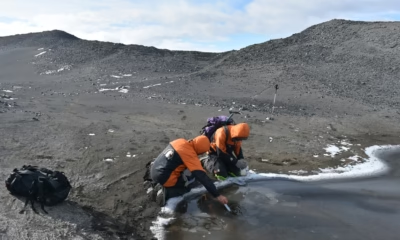Earth
New Study Finds Marine Scrubbers Can Be More Environmentally Friendly Than Low-Sulfur Fuels
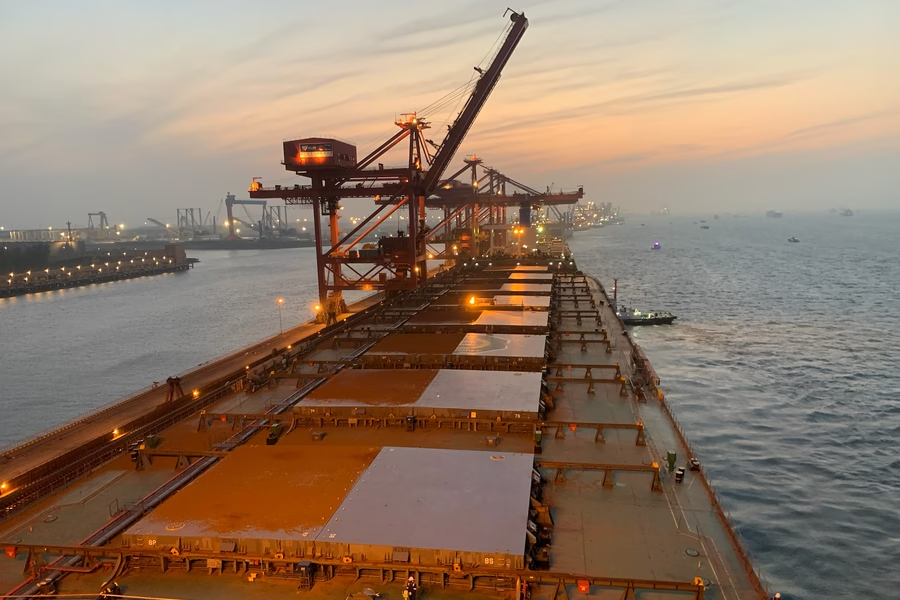
A new study led by researchers from MIT, Georgia Tech, and other institutions suggests that the use of marine scrubbers—devices that clean sulfur emissions from exhaust gases—may be just as environmentally friendly, if not more so, than burning low-sulfur fuels. This groundbreaking research, published in Environmental Science and Technology, challenges the common assumptions about the environmental impact of scrubbers and has important implications for the future of the maritime industry.
The 2020 mandate by the International Maritime Organization (IMO) to cap the sulfur content of marine fuels at 0.5% pushed shipping companies to consider alternatives to the traditionally used heavy fuel oil (HFO), which contains much higher levels of sulfur. The options? Companies could either burn low-sulfur fossil fuels, install exhaust gas cleaning systems (scrubbers), or switch to biofuels. While the latter has been limited by availability, scrubbers became the go-to solution for many, thanks to their cost-effectiveness and ability to enable continued use of cheaper, high-sulfur fuels.
However, a critical question remained: How “green” are scrubbers when viewed through a holistic environmental lens?
“Scrubbers Turned Out to Be an Unexpectedly Deep and Important Transitional Issue”
According to Neil Gershenfeld, MIT professor and senior author of the study, the study explored this question through a comprehensive lifecycle assessment. “In our collaboration with Oldendorff Carriers to broadly explore reducing the environmental impact of shipping, this study of scrubbers turned out to be an unexpectedly deep and important transitional issue,” he explained.
The Study: A Comprehensive “Well-to-Wake” Assessment
The researchers used a “well-to-wake” approach, which examines the environmental impact of fuels and technologies from production to final use. They looked at everything from the manufacturing and transportation of fuels to their emissions when burned on ships. They also gathered data directly from a bulk carrier vessel in China that burns heavy fuel oil with a scrubber and low-sulfur fuel under similar conditions. The team analyzed emissions from the exhaust and samples of washwater discharged from the scrubbers, which is often a concern due to its potential toxicity.
Lead author Patricia Stathatou, an assistant professor at Georgia Tech, emphasized that a full lifecycle analysis is critical for understanding the true environmental impact. “If we just look at everything that happens before the fuel is bunkered onboard the vessel, heavy fuel oil is significantly more low-impact, environmentally, than low-sulfur fuels,” Stathatou said. She added that scrubbers, with a lifetime of about 20 years, have a minimal environmental footprint compared to the energy-intensive production of low-sulfur fuels.
Surprising Findings: Scrubbers Surpass Low-Sulfur Fuels in Several Areas
The results of the study were surprising. When the researchers considered the entire lifecycle, including the production of fuels and scrubbers, burning heavy fuel oil with scrubbers was found to be the least harmful option in terms of most environmental factors, such as greenhouse gas emissions, terrestrial acidification, and ozone formation.
“The claims about environmental hazards and policies to mitigate them should be backed by science,” said Stathatou. “You need to see the data, be objective, and design studies that take into account the full picture to be able to compare different options from an apples-to-apples perspective.”
Scrubbers: A Proven and Mature Technology
Marine scrubbers, which have been used for decades in land-based applications like power plants, are now widely deployed in the shipping industry. Scrubbers are typically large vertical tanks that use seawater to wash sulfur dioxide from the exhaust gases. The seawater reacts with the sulfur, converting it into sulfates, which are environmentally benign. The washwater is then released back into the ocean, where it is diluted by the vast expanse of seawater.
Despite concerns over the acidity and potential pollutants in the washwater, the study found that most chemical concentrations in the washwater were well below the limits set by environmental regulations, such as those from the U.S. Environmental Protection Agency and the European Union.
Scrubbers Meet International Standards
The researchers also tested the washwater for over 60 chemical parameters, including metals and hydrocarbons, and found that concentrations of harmful substances were generally well within safe levels. “Scrubbers reduce sulfur dioxide emissions by 97 percent, making them just as effective as low-sulfur fuels in terms of sulfur emissions,” said Scott Bergeron, managing director of Oldendorff Carriers, who co-authored the study.
A Call for Balanced Environmental Policies
This research has significant implications for future maritime environmental policies. As Stathatou points out, there is growing momentum toward alternative fuels, but it’s critical to assess the environmental impacts of these fuels in comparison to current technologies. “We must do our due diligence to compare them equally with existing solutions to see the costs and benefits,” she said.
The study’s findings could reshape policies governing the maritime industry, suggesting that scrubbers may offer a more sustainable path forward than previously thought. The research team hopes this will prompt a more science-driven approach to reducing shipping’s environmental footprint.
The study, which includes contributions from researchers at MIT, Georgia Tech, and Oldendorff Carriers, highlights the importance of scientific analysis in shaping policies that reduce the environmental impact of global shipping. With over 5,800 vessels now using scrubbers worldwide, the technology is clearly making an impact, but questions around its long-term environmental effects are only just beginning to be answered.
Earth
Meltwater ponds might have sheltered life during earth’s deep freeze
During this time, the planet was believed to be encased in ice, with global temperatures plummeting to as low as -50°C
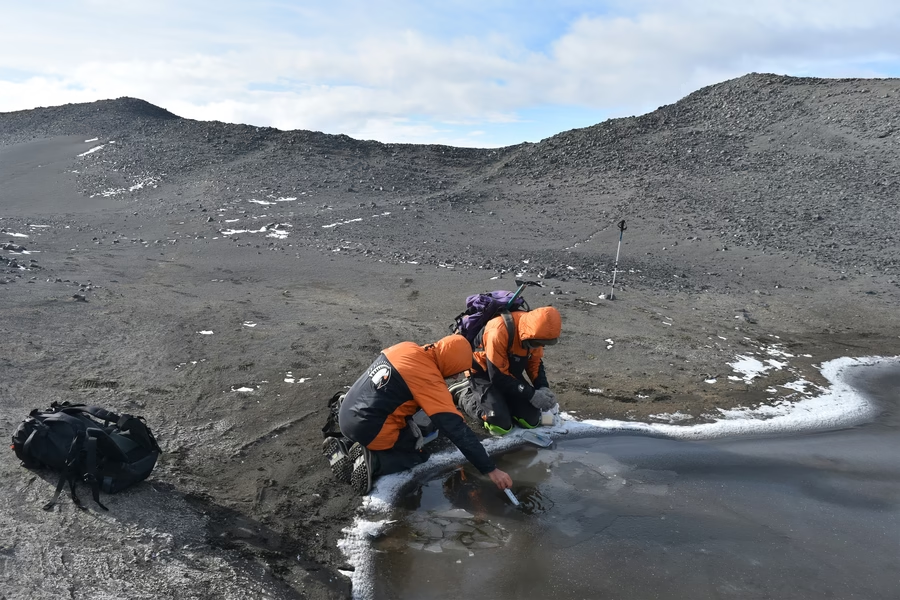
In a study published in Nature Communications, scientists from MIT have proposed that shallow meltwater ponds may have provided critical refuges for early complex life during one of Earth’s most extreme ice ages — the “Snowball Earth” period, which occurred between 635 and 720 million years ago.
During this time, the planet was believed to be encased in ice, with global temperatures plummeting to as low as -50°C. Despite the harsh conditions, complex cellular life — known as eukaryotes — managed to survive. The new research suggests that these life forms could have found sanctuary in small, briny pools formed on the surface of equatorial ice sheets.
“Meltwater ponds are valid candidates for where early eukaryotes could have sheltered during these planet-wide glaciation events,” said lead author Fatima Husain, a graduate researcher in MIT’s Department of Earth, Atmospheric and Planetary Sciences, in a media statement. “This shows us that diversity is present and possible in these sorts of settings. It’s really a story of life’s resilience.”
The team drew parallels between ancient equatorial ice sheets and modern Antarctic conditions. They studied contemporary meltwater ponds on Antarctica’s McMurdo Ice Shelf — an area first dubbed “dirty ice” by explorers in the early 20th century. These ponds, formed by sun-warmed dark debris trapped within surface ice, provided a modern analog to the possible melt environments of the Cryogenian Period.
Samples taken from these Antarctic ponds revealed clear signatures of eukaryotic life. Using chemical and genetic analysis, including the identification of sterols and ribosomal RNA, the researchers detected algae, protists, and microscopic animals — all descendants of early eukaryotes. Each pond supported unique communities, with differences shaped largely by salinity levels.
“No two ponds were alike,” Husain noted. “There are repeating casts of characters, but they’re present in different abundances. We found diverse assemblages of eukaryotes from all the major groups in all the ponds studied.”
These findings suggest that meltwater ponds — overlooked in previous hypotheses — could have served as vital “above-ice oases” for survival and even diversification during Snowball Earth.
“There are many hypotheses for where life could have survived and sheltered during the Cryogenian, but we don’t have excellent analogs for all of them,” Husain explained. “Above-ice meltwater ponds occur on Earth today and are accessible, giving us the opportunity to really focus in on the eukaryotes which live in these environments.”
The study was co-authored by MIT’s Roger Summons, Thomas Evans (formerly MIT), Jasmin Millar of Cardiff University, Anne Jungblut of the Natural History Museum in London, and Ian Hawes of the University of Waikato in New Zealand.
By uncovering how life may have persisted through Earth’s frozen past, the research not only deepens understanding of our planet’s history — it may also help inform the search for life on icy worlds beyond Earth.
Earth
In ancient India, mushy earth made for perfume scent
Kannauj, a city in the Indian state of Uttar Pradesh, offers a sustainable alternative in producing perfumes using traditional modes of distillation.

A sweet scent typically lingers around in the air at Kannauj, an ancient city in India’s most populous state of Uttar Pradesh. It’s an imprint of the countless occasions when it had rained, of roses that bloomed at dawn, and of sandalwood trees that once breathed centuries of calm.. Though mushy smells are not unique to Kannauj, the city utilized traditional distillation methods to make perfume out of these earthly scents.
Kannauj has had a longstanding tradition in perfume-making since four centuries ago. The city, colloquially known as the country’s ancient perfume capital, still uses rustic copper stills, wood-fired ovens, and bamboo pipes leading to sandalwood oil-filled vessels, or attar as it is colloquially known, to make their perfume. Though it gives a pre-industrial look, a closer peek would reveal an ecosystem of complex thermal regulation, plant chemistry, sustainability science, and hydro-distillation chemistry at work.
When synthetically-made but sustainable perfumes, and AI-generated ones share the spotlight today, Kannauj’s tryst with perfumes offer an alternative, sustainable model in traditional distillation, which is inherently low-carbon, zero-waste, and follow principles of a circular economy; all in alignment with sustainable development goals.
Traditional perfume-making is naturally sustainable
In industrial processing, hydro-distillation is a commonly done to separate substances with different boiling points. Heating the liquids produce vapors, which can later be liquefied in a separate chamber. Perfumers in Kannauj follow the same practice, except it promises to be more sustainable with the copper stills, a process colloquially known as dheg-bhakpa hydro-distillation.
There’s no alcohol or synthetic agents in use. Instead, they heat up raw botanicals – such as roses, vetiver roots, jasmine, or even sunbaked clay – to precise temperatures well short of burning, thereby producing fragrant vapor. The vapors are then guided into cooling chambers, where they condense and bond with a natural fixative, often sandalwood oil. Plant residue is the only byproduct, which finds use as organic compost to cultivate another generation of crops.

Trapping earthly scent to make perfume
In the past five years, Kannauj’s veteran perfumers noticed a quiet, but steady shift in their timely harvest and produce. Rose harvests have moved earlier by weeks. Vetiver roots grow shallower due to erratic rainfall. Jasmine yields are fluctuating wildly. The local Ganges river, which influences humidity levels essential for distillation timing, is no longer as predictable. For an entire natural aromatic economy built on seasonal synchrony, this uncertainty has rung alarm bells.
“The scent of a flower depends not just on the flower itself,” Vipin Dixit, a third-generation attar-maker whose family has distilled fragrance for decades, said to EdPublica.
“It depends on the weather the night before, on the heat at sunrise, on the moisture in the air. Even the soil has a scent-memory.”

As a result, perfumers in Kannauj have begun to adapt, applying traditional wisdom through a modern scientific lens. Local distillers are now working with botanists and environmental scientists to study soil microbiomes, measure scent compounds using chromatography, and develop community-based rainwater harvesting to ensure sustainable crop health.
One of the most surprising innovations is trapping petrichor — the scent of first rain — through earth attars. Clay is baked during extreme heat waves, mimicking summer conditions, then distilled to trap the scent of rain hitting dry soil. This aroma, called mitti attar, is one of the few scents in the world created from an environmental phenomenon; and not a flower.
At a time when the world is scrambling to save biodiversity, the humble attar may become a template for green chemistry — one that doesn’t just preserve scent, but also restores the relationship between science, nature, and soul.
Earth
A Region on the Edge: Ocean Heat, Island Peril, and a Global Wake-up Call
Real-world impacts in the South-West Pacific — from disappearing glaciers to cultural erosion in Fiji — illustrate what is at stake.

In a stark warning for the world, the World Meteorological Organization (WMO) released its latest report in June first week, The State of the Climate in the South-West Pacific 2024, painting a vivid picture of escalating climate extremes across ocean and land. The report, released to coincide with the 2025 Global Platform on Disaster Risk Reduction in Geneva and ahead of the 2025 UN Ocean Conference, warns that the South-West Pacific is already grappling with the climate future the rest of the world fears.
A record-breaking Year
2024 marked the warmest year on record for the region, driven by El Niño conditions and unprecedented ocean heating. Nearly 40 million square kilometers — over 10% of the global ocean surface — was scorched by marine heatwaves.
“2024 was the warmest year on record in the South-West Pacific region. Ocean heat and acidification combined to inflict long-lasting damage to marine ecosystems and economies. Sea-level rise is an existential threat to entire island nations. It is increasingly evident that we are fast running out of time to turn the tide,” said WMO Secretary-General Prof. Celeste Saulo in a recent media statement.
The heat was not limited to oceans. Extreme temperatures shattered records in Australia and the Philippines, increasing health risks and straining already vulnerable infrastructure.
Storms, floods, and vanishing ice
The report recounts an unprecedented cyclone season in the Philippines: 12 storms in just three months, affecting over 13 million people and displacing 1.4 million. Meanwhile, Indonesia’s last tropical glacier in New Guinea may vanish by 2026. Satellite estimates show a 30-50% ice loss since 2022.
Precipitation patterns swung to extremes. While Malaysia, Indonesia, and Papua New Guinea faced above-average rainfall and floods, parts of Australia and New Zealand were parched by drought.
The ocean in crisis
The annual sea surface temperature in 2024 was the highest since records began in the early 1980s. Combined with acidification and deoxygenation, ocean warming is devastating marine life and altering storm patterns.
Worryingly, the South-West Pacific sea-level rise already exceeds the global average, threatening islands where over half the population lives within 500 meters of the coast.
Displacement and cultural loss
The Fijian island of Serua, battered by floods and eroding shores, exemplifies the dire choices communities must make.
Despite government offers to relocate, many residents resist because of their deep connection to the land, or “vanua,” a concept embedding identity, spirituality, and ancestry.
“On two separate occasions, the island experienced such extreme flooding that it was possible to cross the entire island by boat without encountering land,” the WMO report said.
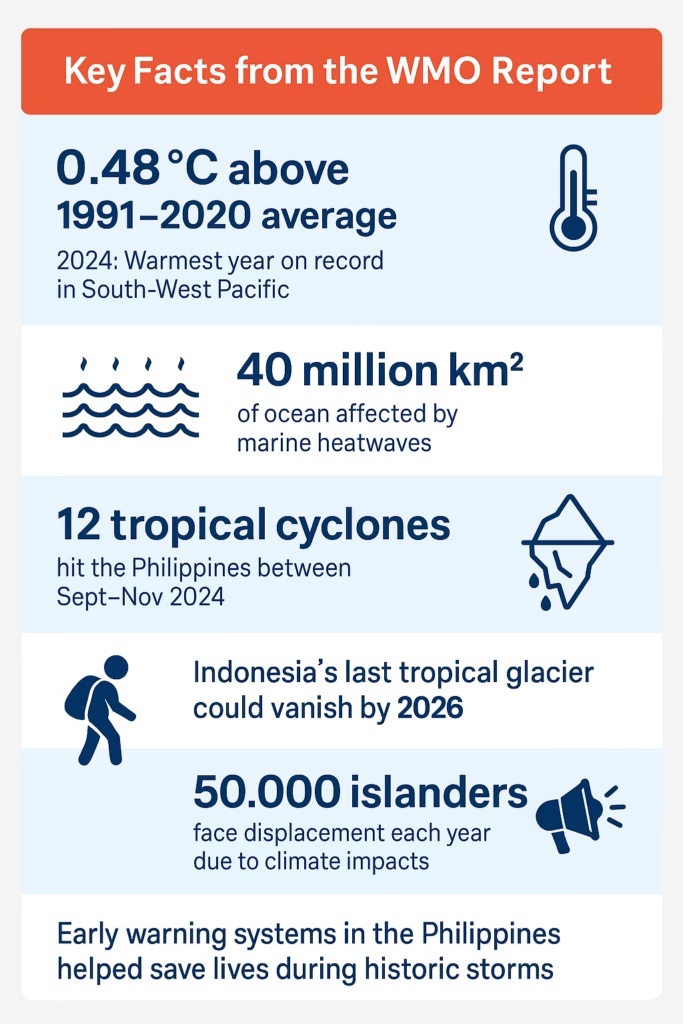
Hope in anticipation: Early warnings save lives
Not all is bleak. A case study from the Philippines showcased how early warning systems and anticipatory action helped mitigate the toll of the 2024 cyclone season. The Food and Agriculture Organization’s anticipatory action teams helped relocate fishing boats and distribute cash aid ahead of the storms.
“While the frequency of tropical cyclones may decrease, their intensity will rise. Building resilience is essential,” the report warns.
A Global Response: UNOC3 Signals Change, But Action Must Follow
As the WMO’s warnings echoed, the United Nations Ocean Conference (UNOC3) concluded in Nice, France (June 9-13, 2025), providing a parallel platform of hope and accountability.
- The High Seas Treaty reached 49 ratifications, nearing the 60 needed for enforcement.
- Nearly $10 billion in funding was pledged for ocean health, though experts note that the real need is $175 billion annually.
- Countries endorsed the 30×30 conservation goal and backed measures against deep-sea mining and plastic pollution.
“We must move from plunder to protection,” said UN Secretary-General António Guterres in his closing address.
These developments reinforce the urgency of the WMO findings. Real-world impacts in the South-West Pacific — from disappearing glaciers to cultural erosion in Fiji — illustrate what is at stake.
The South-West Pacific is not a distant front line. It is the epicenter of an unfolding climate reality. With international mechanisms like the High Seas Treaty nearing activation and early warning systems proving effective, the question is no longer whether we can respond — but whether we will act in time.
As the seas rise and the clock ticks, it’s not just islands at risk. It’s the future of global climate stability.
-

 Society4 months ago
Society4 months agoStarliner crew challenge rhetoric, says they were never “stranded”
-

 Space & Physics3 months ago
Space & Physics3 months agoCould dark energy be a trick played by time?
-

 Earth4 months ago
Earth4 months agoHow IIT Kanpur is Paving the Way for a Solar-Powered Future in India’s Energy Transition
-

 Space & Physics3 months ago
Space & Physics3 months agoSunita Williams aged less in space due to time dilation
-

 Learning & Teaching4 months ago
Learning & Teaching4 months agoCanine Cognitive Abilities: Memory, Intelligence, and Human Interaction
-

 Earth2 months ago
Earth2 months ago122 Forests, 3.2 Million Trees: How One Man Built the World’s Largest Miyawaki Forest
-

 Women In Science3 months ago
Women In Science3 months agoNeena Gupta: Shaping the Future of Algebraic Geometry
-
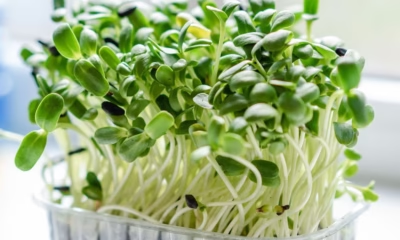
 Society5 months ago
Society5 months agoSustainable Farming: The Microgreens Model from Kerala, South India

